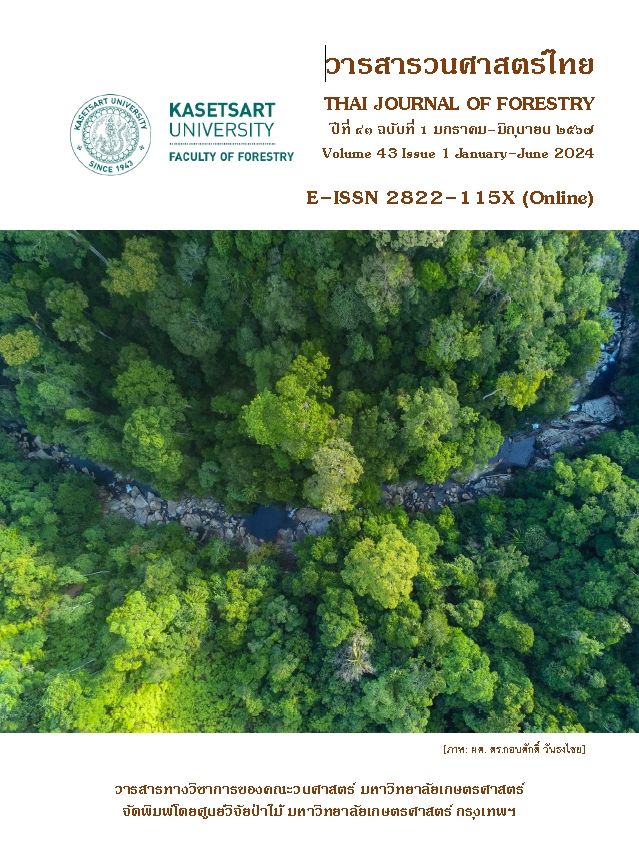การประเมินพื้นที่เสี่ยงต่อการเกิดไฟป่าด้วยภาพถ่ายดาวเทียม ในพื้นที่อุทยานแห่งชาติดอยภูคา จังหวัดน่าน
Main Article Content
บทคัดย่อ
การศึกษาครั้งนี้มีวัตถุประสงค์เพื่อประเมินพื้นที่เสี่ยงต่อการเกิดไฟป่าด้วยภาพถ่ายดาวเทียมในพื้นที่อุทยานแห่งชาติดอยภูคา จังหวัดน่าน จากข้อมูลการสำรวจระยะไกลด้วยดาวเทียม Landsat 8 ระบบบันทึกข้อมูล The Thermal Infrared Sensor (TIRS) เพื่อประมวลผลค่าอุณภูมิพื้นผิว (land surface temperature; LST) ร่วมกับข้อมูลการใช้ประโยชน์ที่ดินเพื่อใช้เป็นปัจจัยสำหรับการประเมินความเสี่ยงการเกิดไฟป่า และใช้ข้อมูลจุดความร้อนที่ได้จากระบบ VIIRS เป็นตัวแทนของไฟป่าที่เกิดขึ้นในพื้นที่ศึกษาและใช้ทดสอบความถูกต้องของข้อมูลพื้นที่เสี่ยงต่อการเดินไฟป่า ช่วงเดือนมีนาคม ระหว่างปี พ.ศ. 2560 – 2564 พบว่า โดยพบการกระจายของจุดความร้อนมากที่สุดในบริเวณที่มีอุณหภูมิพื้นผิวอยู่ในช่วง 23.45องศาเซลเซียส - 31.01 องศา ร้อยละ 77.23 ชนิดป่าที่พบจุดความร้อนมากที่สุด คือ ป่าเบญจพรรณ ร้อยละ 47.52 อำเภอที่มีพื้นที่เสี่ยงการเกิดไฟป่าสูงมากที่สุด ได้แก่ อำเภอแม่จริม โดยมีพื้นที่ 16,889 เฮกตาร์ ลักษณะป่าที่มีพื้นที่เสี่ยงการเกิดไฟป่าสูงที่สุด ได้แก่ ป่าเบญจพรรณ 34,333 เฮกตาร์ (ร้อยละ 56.17) รองลงมาคือ พื้นที่ที่ไม่ใช่ป่า จำนวน 26,249 เฮกตาร์ (ร้อยละ 42.95) ทำให้ได้ฐานข้อมูลที่สามารถกำหนดพื้นที่เสี่ยงภัยต่อการเกิดไฟป่าในอุทยานแห่งชาติดอยภูคา จังหวัดน่านซึ่งจะเป็นประโยชน์ในการวางแผน เพื่อกำหนดมาตรการป้องกันและแก้ไขปัญหาไฟป่าได้ในอนาคตต่อไป
Downloads
Article Details

อนุญาตภายใต้เงื่อนไข Creative Commons Attribution-NonCommercial-NoDerivatives 4.0 International License.
ข้าพเจ้าและผู้เขียนร่วม (ถ้ามี) ขอรับรองว่า ต้นฉบับที่เสนอมานี้ยังไม่เคยได้รับการตีพิมพ์และไม่ได้อยู่ในระหว่างกระบวนการพิจารณาตีพิมพ์ลงในวารสารหรือสิ่งตีพิมพ์อื่นใด ข้าพเจ้าและผู้เขียนร่วม (ถ้ามี) ยอมรับหลักเกณฑ์และเงื่อนไขการพิจารณาต้นฉบับ ทั้งยินยอมให้กองบรรณาธิการมีสิทธิ์พิจารณาและตรวจแก้ต้นฉบับได้ตามที่เห็นสมควร พร้อมนี้ขอมอบลิขสิทธิ์ผลงานที่ได้รับการตีพิมพ์ให้แก่วารสารวนศาสตร์ คณะวนศาสตร์ มหาวิทยาลัยเกษตรศาสตร์ กรณีมีการฟ้องร้องเรื่องการละเมิดลิขสิทธิ์เกี่ยวกับภาพ กราฟ ข้อความส่วนใดส่วนหนึ่ง หรือ ข้อคิดเห็นที่ปรากฏในผลงาน ให้เป็นความรับผิดชอบของข้าพเจ้าและผู้เขียนร่วม (ถ้ามี) แต่เพียงฝ่ายเดียว และหากข้าพเจ้าและผู้เขียนร่วม (ถ้ามี) ประสงค์ถอนบทความในระหว่างกระบวนการพิจารณาของทางวารสาร ข้าพเจ้าและผู้เขียนร่วม (ถ้ามี) ยินดีรับผิดชอบค่าใช้จ่ายทั้งหมดที่เกิดขึ้นในกระบวนการพิจารณาบทความนั้น”
เอกสารอ้างอิง
Dierking, C., Delamere, J. 2021. VIIRS 3.74 µm shortwave IR band. https://gina.alaska.edu/wpcontent/uploads/2021/07/VIIRS_3_74um_FireDetection_Quick_Guide.pdf, 30 November 2021.
Doi Phu Kha National Park. 2022. Doi Phu Kha National Park Management Plan. Department of National Parks, Wildlife and Plant Conservation. Thailand. (in Thai)
Geo-Informatics and Space Technology Development Agency (Public Organization) (GISTDA). 2009. Space Technology and Geo-Informatics. Bangkok, Thailand. (in Thai)
NASA. 2022. FIRMS Fire Information for Resource Management System. https://firms.modaps.eosdis.nasa.gov/, 15 September 2022.
Pal, S., Ziaul, Sk. 2017. Detection of land use and land cover change and land surface temperature in English Bazar urban centre. The Egyptian Journal of Remote Sensing and Space Sciences, 20: 125-145.
Peebkhunthod, U. 2017. Application of Landsat Data for Detecting Land Surface Temperature in Mueang Maha Sarakham District, Maha Sarakham Province. M.E. Thesis, Mahasarakham University, Mahasarakham, Thailand. (in Thai)
Rong-bo, X., Zhi-yun, O., Hua, Z., Wei-feng, L., Erich W, S., Xiao-ke, W. 2007. Spatial pattern of impervious surfaces and their impacts on land surface temperature in Beijing, China. Journal of Environmental Sciences, 19 (2): 250–256.
Rosas, J., Houborg, R., McCabe, M.F. 2017. Sensitivity of Landsat 8 surface temperature estimates to atmospheric profile data: a study using MODTRAN in dryland irrigated systems. Remote Sensing, 9 (10): 988.
Rouse, J.R., Hass, R.H., Schell, J.A., Deering, D.W. 1974. Monitoring Vegetation Systems in the Great Plains with ERTS. Paper A 20. RS Center, Texas A & M University, College Station, Texas. Accessed Via: NASA Technical Report Server, USA.
Royal Forest Department. 2019. Forest Area Data in Thailand Year 2017-2018. https://www.forest.go.th/ land/wp-content/uploads/sites/29/2019/03/final-report-2561.pdf, 15 March 2022.
Suresh, S., Ajay, S.V., Mani, K. 2016. Estimation of land surface temperature of high range mountain landscape of Devikulam taluk using Landsat 8 data. International Journal of Research in Engineering and Technology, 5(1): 92–96.


